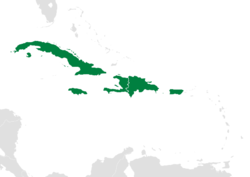
Back الهند الغربية الإسبانية Arabic Španělská Západní Indie Czech Antillas españolas Spanish هند غربی اسپانیا Persian Espanjan Länsi-Intia Finnish Indes occidentales espagnoles French איי הודו המערבית הספרדיים HE Indie occidentali spagnole Italian Ispanijos Vakarų Indijos Lithuanian Шпански Западни Инди Macedonian
Spanish West Indies Las Antillas Españolas | |||||||||||||||
|---|---|---|---|---|---|---|---|---|---|---|---|---|---|---|---|
| 1492–1898 | |||||||||||||||
| Anthem: Marcha Real "Royal March" | |||||||||||||||
 Map of the Greater Antilles, under direct Spanish rule as part of the Viceroyalty of New Spain. | |||||||||||||||
| Status | Possessions of the Spanish Empire | ||||||||||||||
| Capital | Madrid | ||||||||||||||
| Common languages | Spanish, Taino | ||||||||||||||
| Religion | Roman Catholicism | ||||||||||||||
| Demonym(s) | Españoles Antillanos (Spanish Antillean) | ||||||||||||||
| Monarch | |||||||||||||||
• 1492–1504 | Ferdinand II | ||||||||||||||
• 1492–1504 | Isabella I | ||||||||||||||
• 1896–1898 | Alfonso XIII | ||||||||||||||
| Historical era | Spanish colonization | ||||||||||||||
• Columbus landed in San Salvador | 12 October 1492 | ||||||||||||||
| 10 December 1898 | |||||||||||||||
| Currency | Spanish colonial real, Spanish dollar | ||||||||||||||
| ISO 3166 code | ES | ||||||||||||||
| |||||||||||||||
| Today part of | |||||||||||||||
The Spanish West Indies, Spanish Caribbean or the Spanish Antilles (also known as "Las Antillas Occidentales" or simply "Las Antillas Españolas" in Spanish) were Spanish territories in the Caribbean. In terms of governance of the Spanish Empire, The Indies was the designation for all its overseas territories and was overseen by the Council of the Indies, founded in 1524 and based in Spain.[1] When the Crown established the Viceroyalty of New Spain in 1535, the islands of the Caribbean came under its jurisdiction.
The islands ruled by Spain were chiefly the Greater Antilles: Hispaniola (inclusive of modern-day Haiti and the Dominican Republic), Cuba, Jamaica, and Puerto Rico. The majority of the Taíno, the indigenous populations on these islands, had died out or had mixed with the European colonizers by 1520.[2] Spain also claimed the Lesser Antilles including Martinica, but these smaller islands remained largely independent until they were seized or ceded to other European powers as a result of war, or diplomatic agreements during the 17th and 18th centuries.
The islands that became the Spanish West Indies were the focus of the voyages of the Spanish expedition of Christopher Columbus in America. Largely due to the familiarity that Spaniards gained from Columbus's voyages, the islands were also the first lands to be permanently colonized by Europeans in the Americas. The Spanish West Indies were also the most enduring part of Spain's American Empire, only ending with Cuba and Puerto Rico being surrendered in 1898 at the end of the Spanish–American War. For over three centuries, Spain controlled a network of ports in the Caribbean including Havana (Cuba), Santo Domingo (Dominican Republic), San Juan (Puerto Rico), Cartagena de Indias (Colombia), Veracruz (Mexico), and Portobelo (Panama), which were connected by galleon routes.
- ^ Mark A. Burkholder, "Council of the Indies" in Encyclopedia of Latin American History and Culture, vol. 2, p. 293. New York: Charles Scribner's Sons 1996.
- ^ Reséndez, Andrés (2017). The other slavery: The uncovered story of Indian enslavement in America. ISBN 978-0-544-94710-8.

